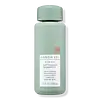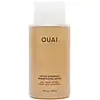What's inside
What's inside
 Benefits
Benefits

 Concerns
Concerns

 Ingredients Side-by-side
Ingredients Side-by-side

Water
Skin ConditioningCocamidopropyl Betaine
CleansingSodium C14-16 Olefin Sulfonate
CleansingDecyl Glucoside
CleansingParfum
MaskingSodium Methyl Cocoyl Taurate
CleansingSorbitol
HumectantCocamide Mipa
EmulsifyingPhenoxyethanol
PreservativeSodium Lauroyl Glycinate
CleansingGlycerin
HumectantPanthenol
Skin ConditioningPEG-150 Distearate
EmulsifyingPEG-200 Hydrogenated Glyceryl Palmate
CleansingStearyl Alcohol
EmollientGuar Hydroxypropyltrimonium Chloride
Skin ConditioningSodium Chloride
MaskingAcrylates Copolymer
Citric Acid
BufferingChlorphenesin
AntimicrobialPEG-7 Glyceryl Cocoate
EmulsifyingPolyquaternium-7
Cetrimonium Chloride
AntimicrobialCoconut Acid
CleansingDisodium EDTA
Ethylhexylglycerin
Skin ConditioningSodium Hydroxide
BufferingIsopropanolamine
BufferingSodium Benzoate
MaskingCoumarin
PerfumingWater, Cocamidopropyl Betaine, Sodium C14-16 Olefin Sulfonate, Decyl Glucoside, Parfum, Sodium Methyl Cocoyl Taurate, Sorbitol, Cocamide Mipa, Phenoxyethanol, Sodium Lauroyl Glycinate, Glycerin, Panthenol, PEG-150 Distearate, PEG-200 Hydrogenated Glyceryl Palmate, Stearyl Alcohol, Guar Hydroxypropyltrimonium Chloride, Sodium Chloride, Acrylates Copolymer, Citric Acid, Chlorphenesin, PEG-7 Glyceryl Cocoate, Polyquaternium-7, Cetrimonium Chloride, Coconut Acid, Disodium EDTA, Ethylhexylglycerin, Sodium Hydroxide, Isopropanolamine, Sodium Benzoate, Coumarin
Water
Skin ConditioningSodium C14-16 Olefin Sulfonate
CleansingSodium Lauroyl Methyl Isethionate
CleansingCocamidopropyl Betaine
CleansingDecyl Glucoside
CleansingAcrylates Copolymer
Cocamide Mipa
EmulsifyingParfum
MaskingPolysorbate 20
EmulsifyingHydrolyzed Keratin
HumectantHydroxypropyl Guar Hydroxypropyltrimonium Chloride
Vinegar
PEG-150 Distearate
EmulsifyingPolyquaternium-7
Glycerin
HumectantBenzophenone-4
UV AbsorberSodium Chloride
MaskingSodium Hydroxide
BufferingTetrasodium EDTA
Trisodium Ethylenediamine Disuccinate
Isopropyl Alcohol
SolventPropylene Glycol
HumectantCitric Acid
BufferingDisodium EDTA
Chlorphenesin
AntimicrobialSodium Benzoate
MaskingPhenoxyethanol
PreservativePotassium Sorbate
PreservativeLinalool
PerfumingCitronellol
PerfumingCI 14700
Cosmetic ColorantCI 19140
Cosmetic ColorantCI 61570
Cosmetic ColorantWater, Sodium C14-16 Olefin Sulfonate, Sodium Lauroyl Methyl Isethionate, Cocamidopropyl Betaine, Decyl Glucoside, Acrylates Copolymer, Cocamide Mipa, Parfum, Polysorbate 20, Hydrolyzed Keratin, Hydroxypropyl Guar Hydroxypropyltrimonium Chloride, Vinegar, PEG-150 Distearate, Polyquaternium-7, Glycerin, Benzophenone-4, Sodium Chloride, Sodium Hydroxide, Tetrasodium EDTA, Trisodium Ethylenediamine Disuccinate, Isopropyl Alcohol, Propylene Glycol, Citric Acid, Disodium EDTA, Chlorphenesin, Sodium Benzoate, Phenoxyethanol, Potassium Sorbate, Linalool, Citronellol, CI 14700, CI 19140, CI 61570
 Reviews
Reviews

Ingredients Explained
These ingredients are found in both products.
Ingredients higher up in an ingredient list are typically present in a larger amount.
Acrylates Copolymer is used as a film-forming agent and texture enhancer.
After applied, Acrylates Copolymer forms a thin film cover that helps skin feel more soft. It can help sunscreens become more water-resistant.
It is also used to make a product more thick.
Learn more about Acrylates CopolymerChlorphenesin is a synthetic preservative. It helps protect a product against bacteria in order to extend shelf life. In most cases, Chlorphenesin is paired with other preservatives such as phenoxyethanol and caprylyl glycol.
Chlorphenesin is a biocide. This means it is able to help fight the microorganisms on our skin. It is also able to fight odor-releasing bacteria.
Chlorphenesin is soluble in both water and glycerin.
Studies show Chlorphenesin is easily absorbed by our skin. You should speak with a skincare professional if you have concerns about using Chlorphenesin.
Learn more about ChlorphenesinCitric Acid is an alpha hydroxy acid (AHA) naturally found in citrus fruits like oranges, lemons, and limes.
Like other AHAs, citric acid can exfoliate skin by breaking down the bonds that hold dead skin cells together. This helps reveal smoother and brighter skin underneath.
However, this exfoliating effect only happens at high concentrations (20%) which can be hard to find in cosmetic products.
Due to this, citric acid is usually included in small amounts as a pH adjuster. This helps keep products slightly more acidic and compatible with skin's natural pH.
In skincare formulas, citric acid can:
While it can provide some skin benefits, research shows lactic acid and glycolic acid are generally more effective and less irritating exfoliants.
Most citric acid used in skincare today is made by fermenting sugars (usually from molasses). This synthetic version is identical to the natural citrus form but easier to stabilize and use in formulations.
Read more about some other popular AHA's here:
Learn more about Citric AcidWe don't have a description for Cocamide Mipa yet.
Cocamidopropyl Betaine is a fatty acid created by mixing similar compounds in coconut oil and dimethylaminopropylamine, a compound with two amino groups.
This ingredient is a surfactant and cleanser. It helps gather the dirt, pollutants, and other impurities in your skin to be washed away. It also helps thicken a product and make the texture more creamy.
Being created from coconut oil means Cocamidopropyl Betaine is hydrating for the skin.
While Cocamidopropyl Betaine was believed to be an allergen, a study from 2012 disproved this. It found two compounds in unpure Cocamidopropyl Betaine to be the irritants: aminoamide and 3-dimethylaminopropylamine. High-grade and pure Cocamidopropyl Betaine did not induce allergic reactions during this study.
Learn more about Cocamidopropyl BetaineDecyl Glucoside is a glucose-based surfactant and emulsion stabilizer. It is created by reacting glucose with the fatty acids from plants.
Surfactants help clean the skin by trapping oil, sebum, and dirt to be washed away. As an emulsion stabilizer, it stabilizes the ingredients in a product by preventing them from separating.
This ingredient is biodegradable and non-toxic. This ingredient is commonly found in baby shampoos.
Decyl Glucoside is sometimes used to stabilize the UV filter Tinosorb.
Learn more about Decyl GlucosideDisodium EDTA plays a role in making products more stable by aiding other preservatives.
It is a chelating agent, meaning it neutralizes metal ions that may be found in a product.
Disodium EDTA is a salt of edetic acid and is found to be safe in cosmetic ingredients.
Learn more about Disodium EDTAGlycerin is already naturally found in your skin. It helps moisturize and protect your skin.
A study from 2016 found glycerin to be more effective as a humectant than AHAs and hyaluronic acid.
As a humectant, it helps the skin stay hydrated by pulling moisture to your skin. The low molecular weight of glycerin allows it to pull moisture into the deeper layers of your skin.
Hydrated skin improves your skin barrier; Your skin barrier helps protect against irritants and bacteria.
Glycerin has also been found to have antimicrobial and antiviral properties. Due to these properties, glycerin is often used in wound and burn treatments.
In cosmetics, glycerin is usually derived from plants such as soybean or palm. However, it can also be sourced from animals, such as tallow or animal fat.
This ingredient is organic, colorless, odorless, and non-toxic.
Glycerin is the name for this ingredient in American English. British English uses Glycerol/Glycerine.
Learn more about GlycerinParfum is a catch-all term for an ingredient or more that is used to give a scent to products.
Also called "fragrance", this ingredient can be a blend of hundreds of chemicals or plant oils. This means every product with "fragrance" or "parfum" in the ingredients list is a different mixture.
For instance, Habanolide is a proprietary trade name for a specific aroma chemical. When used as a fragrance ingredient in cosmetics, most aroma chemicals fall under the broad labeling category of “FRAGRANCE” or “PARFUM” according to EU and US regulations.
The term 'parfum' or 'fragrance' is not regulated in many countries. In many cases, it is up to the brand to define this term.
For instance, many brands choose to label themselves as "fragrance-free" because they are not using synthetic fragrances. However, their products may still contain ingredients such as essential oils that are considered a fragrance by INCI standards.
One example is Calendula flower extract. Calendula is an essential oil that still imparts a scent or 'fragrance'.
Depending on the blend, the ingredients in the mixture can cause allergies and sensitivities on the skin. Some ingredients that are known EU allergens include linalool and citronellol.
Parfum can also be used to mask or cover an unpleasant scent.
The bottom line is: not all fragrances/parfum/ingredients are created equally. If you are worried about fragrances, we recommend taking a closer look at an ingredient. And of course, we always recommend speaking with a professional.
Learn more about ParfumPeg-150 Distearate is an emulsifier and thickening agent. It is created from stearic acid.
As an emulsifier, peg-150 distearate helps other ingredients dissolve. This helps prevent ingredient separation.
This ingredient may not be Malassezia folliculitis, or fungal-acne safe.
Learn more about PEG-150 DistearatePhenoxyethanol is a preservative that has germicide, antimicrobial, and aromatic properties. Studies show that phenoxyethanol can prevent microbial growth. By itself, it has a scent that is similar to that of a rose.
It's often used in formulations along with Caprylyl Glycol to preserve the shelf life of products.
Polyquaternium-7 is a light to clear colored liquid. It is commonly found in haircare products for its film-forming and anti-static properties.
According to a manufacturer, it is a non-paraben and specially developed for negatively charged surfactant systems. This makes it a great hairstyle holder and helps to improve wet hair detangling without adding buildup.
Sodium Benzoate is a preservative. It's used in both cosmetic and food products to inhibit the growth of mold and bacteria. It is typically produced synthetically.
Both the US FDA and EU Health Committee have approved the use of sodium benzoate. In the US, levels of 0.1% (of the total product) are allowed.
Sodium benzoate works as a preservative by inhibiting the growth of bacteria inside of cells. It prevents the cell from fermenting a type of sugar using an enzyme called phosphofructokinase.
It is the salt of benzoic acid. Foods containing sodium benzoate include soda, salad dressings, condiments, fruit juices, wines, and snack foods.
Studies for using ascorbic acid and sodium benzoate in cosmetics are lacking, especially in skincare routines with multiple steps.
We always recommend speaking with a professional, such as a dermatologist, if you have any concerns.
Learn more about Sodium BenzoateSodium C14-16 Olefin Sulfonate is a cleansing agent made from a mixture of long chain sulfonate salts. It can also help produce foam.
This ingredient may be drying. We recommend speaking with a professional if you have concerns.
Chances are, you eat sodium chloride every day. Sodium Chloride is also known as table salt.
This ingredient has many purposes in skincare: thickener, emulsifier, and exfoliator.
You'll most likely find this ingredient in cleansers where it is used to create a gel-like texture. As an emulsifier, it also prevents ingredients from separating.
There is much debate on whether this ingredient is comedogenic. The short answer - comedogenic ratings don't tell the whole story. Learn more about comegodenic ratings here.
The concensus about this ingredient causing acne seems to be divided. Research is needed to understand if this ingredient does cause acne.
Scrubs may use salt as the primary exfoliating ingredient.
Learn more about Sodium ChlorideSodium Hydroxide is also known as lye or caustic soda. It is used to adjust the pH of products; many ingredients require a specific pH to be effective.
In small amounts, sodium hydroxide is considered safe to use. However, large amounts may cause chemical burns due to its high alkaline.
Your skin has a natural pH and acid mantle. This acid mantle helps prevent harmful bacteria from breaking through. The acid mantle also helps keep your skin hydrated.
"Alkaline" refers to a high pH level. A low pH level would be considered acidic.
Learn more about Sodium HydroxideWater. It's the most common cosmetic ingredient of all. You'll usually see it at the top of ingredient lists, meaning that it makes up the largest part of the product.
So why is it so popular? Water most often acts as a solvent - this means that it helps dissolve other ingredients into the formulation.
You'll also recognize water as that liquid we all need to stay alive. If you see this, drink a glass of water. Stay hydrated!
Learn more about Water